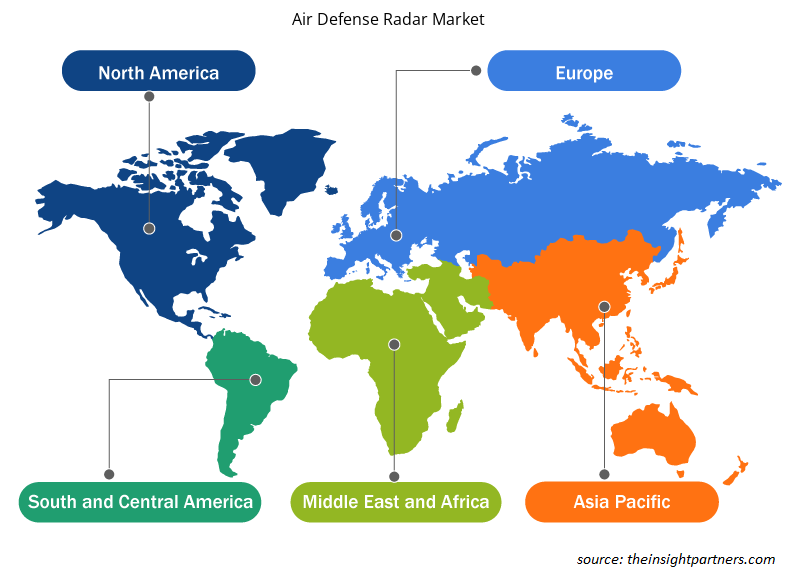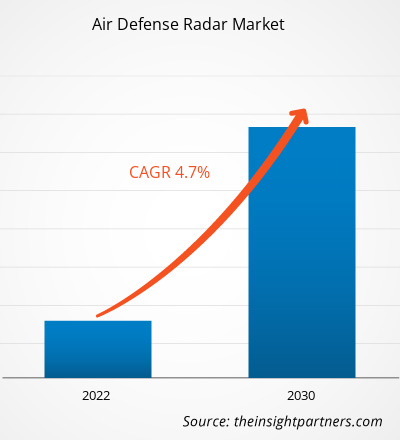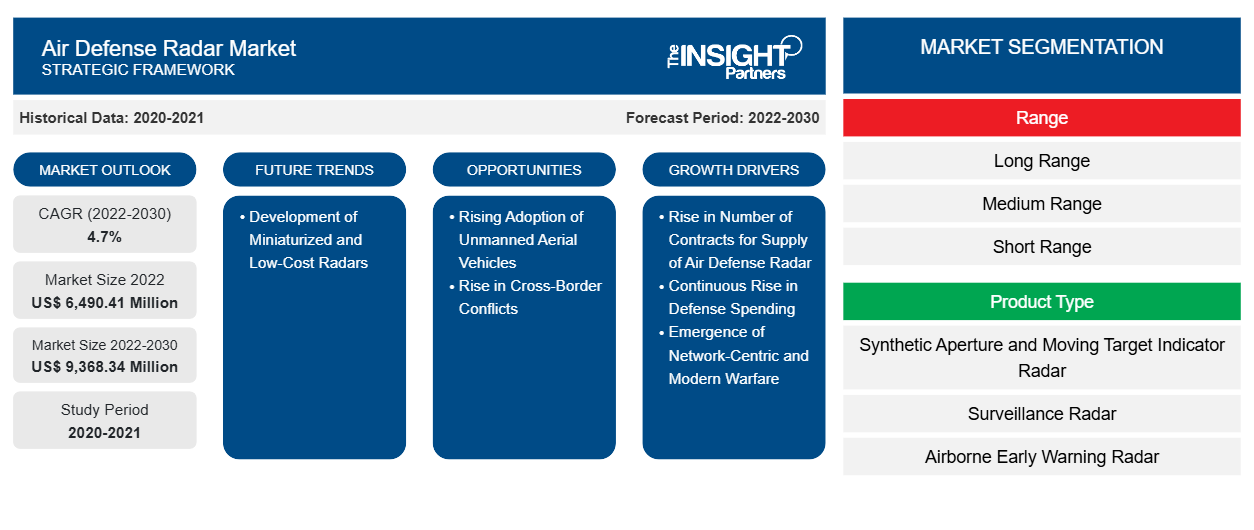Si prevede che la dimensione del mercato dei radar di difesa aerea raggiungerà i 9.368,34 milioni di dollari entro il 2030, rispetto ai 6.490,41 milioni di dollari del 2022. Si prevede che il mercato registrerà un CAGR del 4,7% nel 2022-2030. È probabile che lo sviluppo di radar miniaturizzati e a basso costo rimanga una tendenza chiave del mercato dei radar di difesa aerea.
Analisi del mercato dei radar di difesa aerea
Le tecniche di jamming e spoofing possono degradare la consapevolezza della situazione fornita dai sistemi radar di difesa aerea. Interferendo con i segnali radar o fornendo false informazioni, queste tecniche possono fuorviare operatori e decisori, portando a valutazioni imprecise della minaccia. Una ridotta consapevolezza della situazione ostacola la capacità di rispondere efficacemente alle minacce aeree e può compromettere il successo complessivo della missione. I produttori e gli operatori di sistemi radar sviluppano continuamente contromisure per mitigare l'impatto delle tecniche di jamming e spoofing. Queste contromisure possono comportare algoritmi avanzati di elaborazione del segnale, generazione di forme d'onda adattive o l'integrazione di sistemi di sensori complementari. Tuttavia, con l'evoluzione delle contromisure, gli avversari possono sviluppare tecniche di jamming e spoofing più sofisticate, che richiedono investimenti continui in ricerca e sviluppo. Per mitigare l'impatto delle tecniche di jamming e spoofing spesso è necessario integrare tecnologie e sistemi aggiuntivi nelle architetture radar. Ciò può aumentare il costo e la complessità dei sistemi radar di difesa aerea, rendendo più difficili il loro approvvigionamento e la loro manutenzione. Le organizzazioni devono investire in efficaci capacità di contromisure, formazione e aggiornamenti regolari per restare al passo con l'evoluzione delle tecniche di jamming e spoofing.
Panoramica del mercato dei radar per la difesa aerea
Gli utenti finali dei radar di difesa aerea possono variare a seconda dell'applicazione specifica e dell'organizzazione responsabile della difesa e della sicurezza. Possono essere utilizzati da forze militari come eserciti nazionali, forze aeree e forze navali e agenzie di sicurezza delle frontiere . Possono anche essere utilizzati nei sistemi di controllo del traffico aereo militare. Inoltre, i radar di difesa aerea svolgono un ruolo cruciale nei sistemi di difesa aerea della NATO (Organizzazione del Trattato del Nord Atlantico) e delle forze alleate. Questi radar mantengono anche la difesa e la sicurezza dei paesi membri dell'UE, fornendo consapevolezza della situazione e contribuendo alle operazioni di difesa congiunte. Inoltre, alcuni utenti finali dei radar di difesa aerea possono variare in base al contesto geopolitico e ai requisiti specifici di ciascun paese o organizzazione.
Personalizza questo report in base alle tue esigenze
Riceverai la personalizzazione gratuita di qualsiasi report, comprese parti di questo report, o analisi a livello nazionale, pacchetto dati Excel, oltre a usufruire di grandi offerte e sconti per start-up e università
-
Scopri le principali tendenze di mercato in questo rapporto.Questo campione GRATUITO includerà analisi di dati che spaziano dalle tendenze di mercato alle stime e alle previsioni.
Driver e opportunità del mercato dei radar per la difesa aerea
L'emergere della guerra moderna e incentrata sulla rete
La guerra incentrata sulla rete si basa sulla rapida condivisione, fusione e analisi dei dati raccolti da più fonti. I sistemi radar di difesa aerea generano dati essenziali per la fusione e la correlazione utilizzando input da altri sensori e fonti di intelligence. Ciò facilita lo sviluppo di un quadro aereo completo e accurato, consentendo valutazioni delle minacce e impegni di obiettivi più precisi. Pertanto, i concetti di guerra incentrata sulla rete e di guerra moderna enfatizzano una maggiore consapevolezza della situazione, sistemi di difesa integrati, rapida condivisione dei dati, impegno di obiettivi migliorato, capacità di guerra elettronica e adattabilità alle minacce in evoluzione. Pertanto, la crescente adozione della guerra incentrata sulla rete e moderna sta ulteriormente guidando gli sviluppi nelle tecnologie radar avanzate per supportare un'efficace difesa aerea in moderni ambienti operativi.
Aumento dei conflitti transfrontalieri: un’opportunità nel mercato dei radar di difesa aerea
La tensione costante tra paesi come India-Pakistan, Cina-Taiwan, Cina-India, Russia-Ucraina e Israele-Palestina sta costringendo i rispettivi governi a rafforzare le forze armate. Quindi, le forze armate di questi paesi si stanno concentrando sull'approvvigionamento di sistemi di difesa aerea. I conflitti transfrontalieri spesso comportano minacce da piattaforme aviotrasportate, tra cui aerei, UAS e missili. I sistemi radar di difesa aerea svolgono un ruolo fondamentale nella sorveglianza dei confini rilevando e tracciando queste minacce, fornendo un allarme tempestivo e consentendo capacità di risposta rapida, comprese misure di evacuazione. I conflitti transfrontalieri potrebbero anche portare alla distruzione di infrastrutture critiche, come aeroporti, centrali elettriche e varie strutture governative. La necessità di una sorveglianza migliorata per salvaguardare i confini e altre infrastrutture critiche spinge la domanda di sistemi radar avanzati, tra cui sistemi radar di difesa aerea, nelle zone di conflitto. Inoltre, le forze militari spesso stabiliscono basi operative avanzate (FOB) vicino alle zone di conflitto. Queste FOB richiedono solide capacità di difesa aerea per proteggere personale e attrezzature. I sistemi radar di difesa aerea sono parte integrante delle FOB, fornendo capacità di sorveglianza, rilevamento e risposta contro le minacce aeree. Pertanto, si prevede che l'aumento dell'utilizzo dei radar di difesa aerea nelle aree di conflitto creerà opportunità per la crescita del mercato dei radar di difesa aerea nei prossimi anni.
Analisi della segmentazione del rapporto di mercato del radar di difesa aerea
I segmenti chiave che hanno contribuito alla derivazione dell'analisi di mercato dei radar per la difesa aerea sono portata, tipo di prodotto, tipo di sistema, piattaforma e applicazione.
- In base alla portata, il mercato dei radar di difesa aerea è suddiviso in lungo, medio e corto raggio. Il segmento a lungo raggio ha detenuto una quota di mercato maggiore nel 2022.
- In base al tipo di prodotto, il mercato dei radar per la difesa aerea è segmentato in radar ad apertura sintetica e indicatore di bersaglio in movimento, radar di sorveglianza, radar di allerta precoce aviotrasportato, radar multifunzionale, radar meteorologico e altri. Il segmento dei radar ad apertura sintetica e indicatore di bersaglio in movimento ha detenuto una quota di mercato maggiore nel 2022.
- In base al tipo di sistema, il mercato dei radar di difesa aerea è segmentato in fisso e portatile. Il segmento dei radar fissi ha detenuto una quota di mercato maggiore nel 2022.
- In base alla piattaforma, il mercato dei radar di difesa aerea è segmentato in terrestre, montato su aeromobili e navale. Il segmento terrestre ha detenuto una quota di mercato maggiore nel 2022.
- In base all'applicazione, il mercato dei radar di difesa aerea è segmentato in difesa missilistica balistica, identificazione amico o nemico, previsioni meteorologiche e altri. Il segmento di identificazione amico o nemico ha detenuto una quota di mercato maggiore nel 2022.
Analisi della quota di mercato dei radar di difesa aerea per area geografica
L'ambito geografico del rapporto sul mercato dei radar per la difesa aerea è suddiviso principalmente in cinque regioni: Nord America, Asia Pacifico, Europa, Medio Oriente e Africa e Sud America.
Nel 2023, il Nord America ha rappresentato una quota importante nel mercato globale dei radar di difesa aerea, seguito da Europa e Asia Pacifico. Il mercato dei radar di difesa aerea in Nord America è guidato principalmente da attori chiave come General Dynamics Corporation, Honeywell International Inc, Lockheed Martin Corporation, Northrop Grumman Corporation e Raytheon Technologies Corporation. Inoltre, la tensione geopolitica nella regione sta aumentando la spesa militare. Secondo lo Stockholm International Peace Research Institute (SIPRI), la spesa militare del Nord America è stata di 809.723,4 milioni di dollari nel 2020; è aumentata a 840.273,3 milioni di dollari nel 2021 e ha raggiunto 912.375,03 milioni di dollari nel 2022. Pertanto, il crescente budget militare sta stimolando l'acquisto di vari sistemi di difesa. Secondo il World Directory of Modern Military Aircraft (WDMMA) e il Global Fire Power Index (FPI), il Nord America detiene attualmente 466 flotte, tra cui fregate, corvette, cacciatorpediniere, portaerei e sottomarini. Oltre a queste, nel 2023, la regione si è assicurata 72 flotte per futuri acquisti. Poiché i sistemi radar svolgono un ruolo essenziale nell'identificazione del bersaglio, nelle capacità di tracciamento dei sistemi di difesa, si prevede che l'aumento degli acquisti di sistemi di difesa stimolerà la domanda di sistemi radar di difesa aerea durante il periodo di previsione.
Approfondimenti regionali sul mercato dei radar per la difesa aerea
Le tendenze regionali e i fattori che influenzano il mercato dei radar di difesa aerea durante il periodo di previsione sono stati ampiamente spiegati dagli analisti di Insight Partners. Questa sezione discute anche i segmenti e la geografia del mercato dei radar di difesa aerea in Nord America, Europa, Asia Pacifico, Medio Oriente e Africa e America meridionale e centrale.

- Ottieni i dati specifici regionali per il mercato dei radar di difesa aerea
Ambito del rapporto sul mercato dei radar di difesa aerea
| Attributo del report | Dettagli |
|---|---|
| Dimensioni del mercato nel 2022 | 6.490,41 milioni di dollari USA |
| Dimensioni del mercato entro il 2030 | 9.368,34 milioni di dollari USA |
| CAGR globale (2022-2030) | 4,7% |
| Dati storici | 2020-2021 |
| Periodo di previsione | 2022-2030 |
| Segmenti coperti |
Per intervallo
|
| Regioni e Paesi coperti |
America del Nord
|
| Leader di mercato e profili aziendali chiave |
|
Densità degli attori del mercato: comprendere il suo impatto sulle dinamiche aziendali
Il mercato del radar di difesa aerea sta crescendo rapidamente, spinto dalla crescente domanda degli utenti finali dovuta a fattori quali l'evoluzione delle preferenze dei consumatori, i progressi tecnologici e una maggiore consapevolezza dei vantaggi del prodotto. Con l'aumento della domanda, le aziende stanno ampliando le loro offerte, innovando per soddisfare le esigenze dei consumatori e capitalizzando sulle tendenze emergenti, il che alimenta ulteriormente la crescita del mercato.
La densità degli operatori di mercato si riferisce alla distribuzione di aziende o società che operano in un particolare mercato o settore. Indica quanti concorrenti (operatori di mercato) sono presenti in un dato spazio di mercato in relazione alle sue dimensioni o al valore di mercato totale.
Le principali aziende che operano nel mercato dei radar per la difesa aerea sono:
- Sistemi BAE Plc
- General Dynamics Corp
- Honeywell International Inc
- Industrie aerospaziali israeliane Ltd
- Leonardo SpA
- Società per azioni Lockheed Martin
Disclaimer : le aziende elencate sopra non sono classificate secondo un ordine particolare.

- Ottieni una panoramica dei principali attori del mercato dei radar di difesa aerea
Notizie e sviluppi recenti sul mercato dei radar di difesa aerea
Il mercato dei radar di difesa aerea viene valutato raccogliendo dati qualitativi e quantitativi dopo la ricerca primaria e secondaria, che includono importanti pubblicazioni aziendali, dati associativi e database. Di seguito è riportato un elenco degli sviluppi nel mercato per innovazioni, espansione aziendale e strategie:
- Nel 2023, Honeywell ha annunciato che la Guardia costiera degli Stati Uniti (USCG) ha selezionato il sistema radar meteorologico IntuVue RDR-7000 di Honeywell come aggiornamento dei sistemi esistenti sui suoi elicotteri multimissione Sikorsky MH-60 Jayhawk ed Eurocopter MH-65 Dolphin. L'aggiornamento RDR-7000 si basa sulla solida tradizione di prestazioni e consapevolezza della situazione fornita dal sistema radar meteorologico Honeywell P701 attualmente installato. (Fonte: Honeywell International Inc, comunicato stampa)
- Nel 2023, la Royal Norwegian Air Force ha selezionato il radar di sorveglianza aerea terrestre di nuova generazione Lockheed Martin TPY-4 per migliorare la capacità di sorveglianza a lungo raggio del paese. I radar TPY-4 della Norvegia saranno integrati nella linea di produzione attiva di Lockheed Martin, rendendo questa un'opzione a basso rischio per la Norwegian Defence Material Agency. (Fonte: Lockheed Martin Corporation, Newsletter)
Copertura e risultati del rapporto sul mercato dei radar di difesa aerea
Il rapporto "Dimensioni e previsioni del mercato dei radar di difesa aerea (2020-2030)" fornisce un'analisi dettagliata del mercato che copre le seguenti aree:
- Dimensioni e previsioni del mercato dei radar per la difesa aerea a livello globale, regionale e nazionale per tutti i segmenti di mercato chiave coperti dall'ambito
- Dinamiche di mercato come fattori trainanti, vincoli e opportunità chiave
- Tendenze del mercato dei radar di difesa aerea
- Le cinque forze di Porter in dettaglio
- Analisi del mercato dei radar di difesa aerea che copre le principali tendenze del mercato, il quadro globale e regionale, i principali attori, le normative e i recenti sviluppi del mercato
- Analisi del panorama e della concorrenza del settore dei radar per la difesa aerea che copre la concentrazione del mercato, l'analisi della mappa di calore, i principali attori e gli sviluppi recenti
- Profili aziendali dettagliati
- Analisi storica (2 anni), anno base, previsione (7 anni) con CAGR
- Analisi PEST e SWOT
- Valore/volume delle dimensioni del mercato - Globale, Regionale, Nazionale
- Industria e panorama competitivo
- Set di dati Excel
Report recenti
Rapporti correlati
Testimonianze
Motivo dell'acquisto
- Processo decisionale informato
- Comprensione delle dinamiche di mercato
- Analisi competitiva
- Analisi dei clienti
- Previsioni di mercato
- Mitigazione del rischio
- Pianificazione strategica
- Giustificazione degli investimenti
- Identificazione dei mercati emergenti
- Miglioramento delle strategie di marketing
- Aumento dell'efficienza operativa
- Allineamento alle tendenze normative























 Ottieni un campione gratuito per - Mercato dei radar per la difesa aerea
Ottieni un campione gratuito per - Mercato dei radar per la difesa aerea